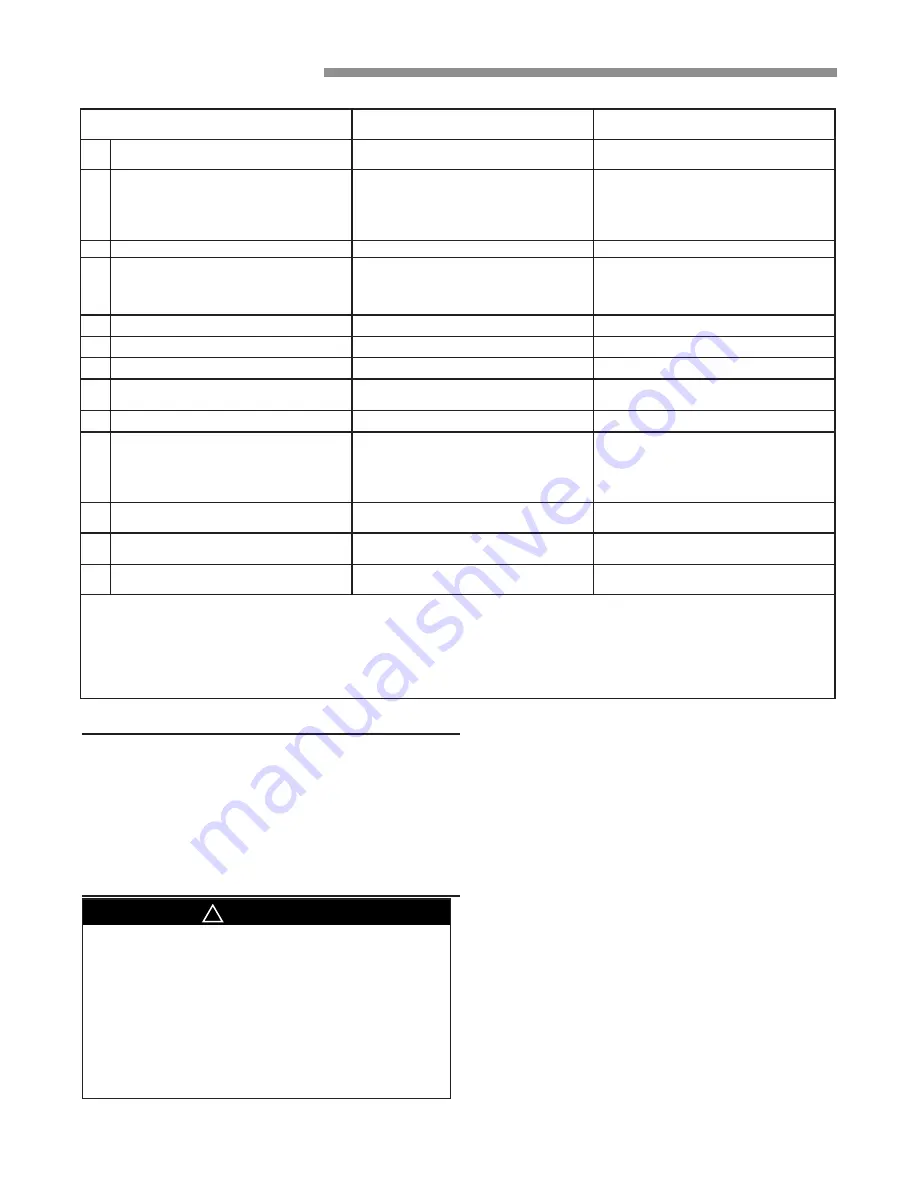
16 18-CD35D1-1
INSTALLER’S GUIDE
Table 13 - See Figure 26-Direct Vent Terminal
Clearances
Canadian Installations
US Installations
A=
Clearance above grade, veranda, porch,
deck, or balcony
12 inches (30 cm)
12 inches (30 cm)
B=
Clearance to window or door that may be
opened
6 inches (15 cm) for appliances =/<
10,000 Btuh (3 kw), 12 inches (30 cm) for
appliances > 10,000 Btuh (3 kw) and =/<
100,000 Btuh (30 kw), 36 inches (91 cm) for
appliances > 100,000 Btuh (30 kw)
6 inches (15 cm) for appliances =/< 10,000
Btuh (3 kw), 9 inches (23 cm) for appliances
> 10,000 Btuh (3 kw) and =/< 50,000 Btuh
(15 kw), 12 inches (30 cm) for appliances >
50,000 Btuh (15 kw)
C=
Clearance to permanently closed window
*
*
D=
Vertical clearance to ventilated soffit located
above the terminal within a horizontal
distance of 2 feet (61 cm) from the center
line of the terminal
*
*
E=
Clearance to unventilated soffit
*
*
F=
Clearance to outside corner
*
*
G= Clearance to inside corner
*
*
H=
Clearance to each side of center line
extended above meter/regulator assembly
3 feet (91 cm) with a height 15 feet (4.5 m)
above the meter/regulator assembly
*
I=
Clearance to service regulator vent outlet
3 feet (91 cm)
*
J=
Clearance to nonmechanical air supply inlet
to building or the combustion air inlet to any
other appliance
6 inches (15 cm) for appliances =/<
10,000 Btuh (3 kw), 12 inches (30 cm) for
appliances > 10,000 Btuh (3 kw) and =/<
100,000 Btuh (30 kw), 36 inches (91 cm) for
appliances > 100,000 Btuh (30 kw)
6 inches (15 cm) for appliances =/< 10,000
Btuh (3 kw), 9 inches (23 cm) for appliances
> 10,000 Btuh (3 kw) and =/< 50,000 Btuh
(15 kw), 12 inches (30 cm) for appliances >
50,000 Btuh (15 kw)
K=
Clearance to a mechanical air supply inlet
6 feet (1.83m)
3 feet (91 cm) above if within 10 feet (3m)
horizontally
L=
Clearance above a paved sidewalk or paved
driveway located on public property
7 feet (2.13 m) †
*
M= Clearance under veranda, porch, deck, or
balcony
`12 inches (30 cm) ‡
*
Notes:
1. In accordance with the current CSA B149.1 Natural Gas and Propane Installation Code.
2. In accordance with the current ANSI Z223.1/NFPA 54 National Fuel Gas Code.
†. A vent shall not terminate directly above a sidewalk or paved driveway that is located between two single family dwelling and serves both
dwellings.
‡. Permitted only if veranda, porch, deck, or balcony is fully open on a minimum of two sides beneath the floor.
* Clearance in accordance with local installation codes and the requirements of the gas supplier and the manufacturer's Installation Instructions.
HORIZONTAL VENTING
NOTE:
Vent termination kit BAYAIR30AVENTA or
BAYVENT200B may be used instead of the
horizontal and vertical termination options shown
in the following figures. For Canadian applications
Only: IPEX 196006 may be used for horizontal and
vertical terminations. IPEX 081216, IPEX 081218,
and IPEX 081219 may only be used for horizontal
vent terminations.
▲
CAUTION
!
When the vent pipe is exposed to temperatures
below freezing, i.e., when it passes through
unheated spaces, etc., the pipe must be insulated
with 1/2 inch (22.7 mm) thick Armaflex-type
insulation or equal. If the space is heated
sufficiently to prevent freezing, then the insulation
would not be required. If domestic water pipes are
not protected from freezing then it is assumed the
space meets the condition of a heated space.
HORIZONTAL VENTING THROUGH WALL
These furnaces may be installed as direct vent (as shipped) or as
non-direct vent. Installation must conform to national, state, and
local codes.
The vent and inlet terminals must be located at least 12" minimum
(18" in Canada) above normally expected snow accumulation
level.
Avoid areas where staining or condensate drippage may be a
problem.
Location of the vent/ wind terminal should be chosen to meet
the requirements of Figure 26 for either direct or non-direct vent
applications.
PITCH
– Venting through the wall must maintain 1/4" per foot
pitched upward to insure that condensate drains back to the
furnace.







































